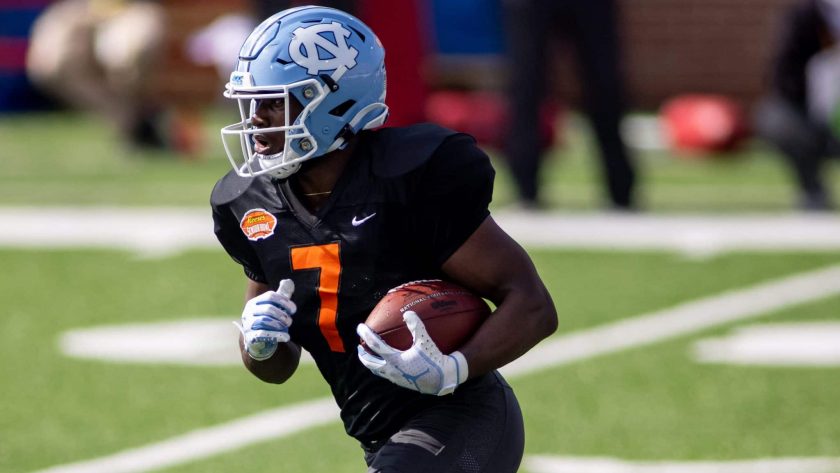How may the Jets utilize 4th-round RB Michael Carter?

The Jets executed a steal in the draft by selecting running back Michael Carter in the fourth round. What role(s) could he assume?
[sc name=”ryan-honey-banner” ][/sc]Acquiring North Carolina running back Michael Carter in the fourth round was a superb value pick for the Jets.
It was just another selection that made this year’s annual draft a success for Joe Douglas and co. Carter is a versatile athlete who can bring immense talent to an offense that desperately requires it.
The Jets should absolutely look to maximize Carter’s pro-level potential, which is why the team must utilize him in various facets.
Offensively: A committee-based approach
At this moment in time, it doesn’t seem like there will be a concrete lead dog for the Jets running back room.
And there shouldn’t be.
The Jets employ a trio of backs who can respectively produce.
While 2020 fourth-round pick La’Mical Perine sports a larger frame (5-foot-11, 216 pounds) and can succeed in short-yardage scenarios, veteran free-agent pickup Tevin Coleman could be more of a pass-catching back.
Carter, on the other hand, can be that speedy first-down weapon that portrays sheer acceleration and elusiveness once he finds space.
The Jets may be best off utilizing Carter on outside-the-tackle run plays for the majority of his time on the field.
Divvying up the run-game responsibilities, overall, would be helpful for a Jets offense searching for improvement (New York was 32nd in both total yards and points last year).
For one, it would keep the legs of Carter, Perine, and Coleman fresh and prevent any single individual from becoming overwhelmed with on-field responsibility.
It would also keep opposing defenses on their toes and, most importantly, provide Zach Wilson with enhanced assistance. The rookie quarterback will need all the help he can get to develop — possessing a number of reliable backs (who could all take pressure off of him) would be nothing but beneficial.
Special Teams: Get the ball in Carter’s hands
If the Jets are going to use Carter on special teams, they must provide him with a role (or roles) that leads to the ball potentially being in his grasp; his speed, acceleration, and pure athleticism are too valuable for this not to be the case.
His collegiate experience as a punt returner was non-existent, but the same can’t be said of his experience as a kickoff return specialist.
Carter returned 29 kicks for 650 yards (22.4 yards per return) during his days with the Tar Heels.
Throughout the earlier stages of his professional career, Carter could locate notable reps in this area and possibly produce at a high level.
The QB-RB connection is critical
Carter will be a first-year asset within a young Jets offense that also includes a rookie signal-caller.
Wilson is currently slated to start for New York, there’s no doubt about it; we are aware of Carter’s potential role(s), we’ve discussed it.
But one of the things that stands crucial is the connection between the two.
The No. 2 overall pick is expected to elevate Carter and work to maximize his talent and potential while Carter should provide Wilson with another passing-game target and also take pressure off of him in the run game.
Regardless of Carter’s rookie-season role(s), the chemistry built between the two rookies will carry immense importance in regard to the success of this unit.
- DRAFTKINGS SPORTSBOOK
BET $5 & GET $150 IN BONUS BETS INSTANTLY!
- FANDUEL SPORTSBOOK
BET $5, GET $150 BONUS!
- CAESARS SPORTSBOOK
$1,000 BET ON CAESARS!
- BETMGM SPORTSBOOK
BET $5, GET $158 BONUS!
- BET365
GET $150 BONUS OR $2,000 FIRST-BET SAFETY NET!











